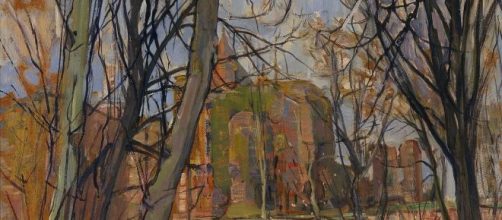It's been said that people don't change. Dr. Jeremy Sherman was pretty certain about that in Psychology Today in 2014. Clearly, he didn't know Piet Mondrian who started out painting landscapes like an Impressionist and ended up believing that painting didn't require a subject and didn't even have to remind us of anything.
It's not your fault
If you think people don't change, consider the exhibit "The Figurative Mondrian" at Musee Marmottan, Paris. Not that anyone can be faulted for thinking we"re fixated in our ways. Be-Art magazine, reviewing the exhibit, points out that Mondrian's figurative work "started like Corot." He also borrowed from other painters like Seurat, Gauguin, Van Gogh, Cezanne.
This isn't generally known because for a long time his pictorial work was held in the private collection of the painter's patron Salomon Slijper.
Driven to abstraction
So, one may ask, what made Mondrian switch from figurative to abstract? To hear John Canaday tell it in his 1959 book "Mainstreams of Modern Art," it was the chaos of modern life that drove him to abstraction. He was after order and a kind of purity by restricting unmixed primary colors in grids of straight vertical and horizontal black lines. Mondrian thought this style fit the modern mindset because it had a technological air. Art world kingmaker Peggy Guggenheim wasn't sure about what Mondrian was doing and, according to Hyperallergic, asked Jackson Pollock for his endorsement.
Pictorial versus non-objective
As it turned out, Mondrian's switch in style wasn't just some mood swing. He wrote at length on the subject and became a leader in the abstract art movement, In his book "Natural Reality and Abstract Reality" 1919, he wrote, "All painting is composed of line and color... [and] they must be freed from their bondage to the imitation of nature and allowed to exist for themselves.” Arguing further against recognizable imagery, he said that non-figurative art shows that art is not the expression of the appearance of reality, but that it is the expression of true reality and true life - "indefinable, but realizable.”
Putting beliefs into action
Mondrian not only rejected landscape painting but acted out his rejection.
Donald Hall and Pat Corrington Wykes tell a story in their 1990 book "Anecdotes Modern Art." It was recounted by Nina Kandinsky, wife of Wassily Kandinsky, founder of abstract art: “I will never forget Piet Mondrian’s visit to our apartment. It was on a glorious spring day. Chestnut trees in front of our building were in blossom. Kandinsky had placed the little tea-table in such a way that Mondrian could look out on all of their flowering splendor. Mondrian, of course, insisted on taking a different seat, so as to turn his back on nature.”


